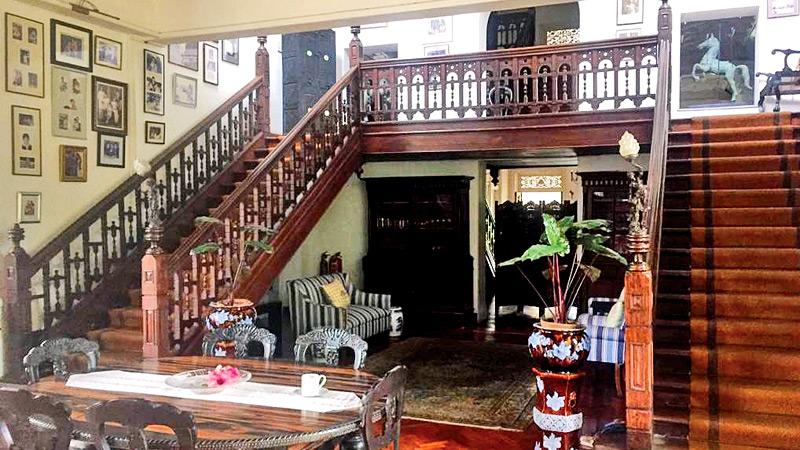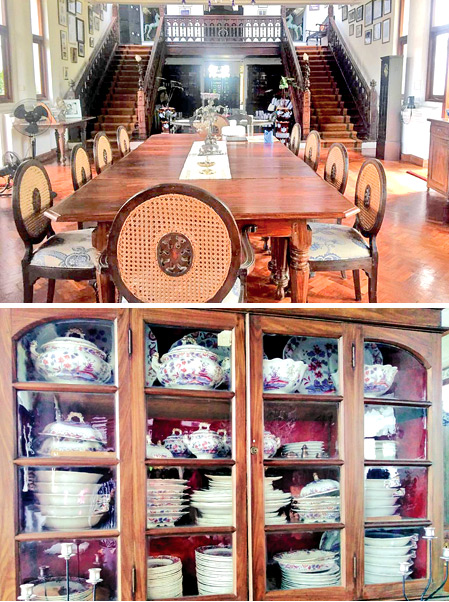
During the period when Sri Lanka or Ceylon as it was known then, was under the Europeans, Ceylonese also held various positions.
In particular, positions such as Mudali (Mudaliyar) and Mahamudali were given to members of local aristocratic families who sided with the colonial rulers.
The houses in which they lived were different from those in which the ordinary people lived, and were called “Walawas”.
However, with the end of the colonial era and after gaining independence, the respect of the people for such aristocratic families gradually waned.
Hotels
This is well reflected in books such as ‘Gamperaliya’ written by the late Martin Wickramasinghe. Many Walawas were sold to foreigners and various companies because their owners could not maintain them, and today some of them can be seen being used for various businesses such as tourist hotels.
 However, the Horagolla Walawwa in Nittambuwa, Gampaha, district which is believed to have been built by an ancestor of the late Maha Mudaliyar Solomon Dias Bandaranaike, during the British rule in Sri Lanka, is one of the most important of these.
However, the Horagolla Walawwa in Nittambuwa, Gampaha, district which is believed to have been built by an ancestor of the late Maha Mudaliyar Solomon Dias Bandaranaike, during the British rule in Sri Lanka, is one of the most important of these.
Horagolla Walawwa, which is believed to have been built around 1820, was the house for slain Solomon West Ridgeway Dias Bandaranaike, the fourth Prime Minister of Ceylon, and his wife, the late Sirimavo Ratwatte Dias Bandaranaike, who became the first female Prime Minister of the world, Chandrika Bandaranaike Kumaratunga, former President and the late Anura Priyadarshi Solomon Dias Bandaranaike, a former Speaker of the House, Leader of the Opposition and a Minister.
Land
According to some sources, late Solomon Dias Bandaranaike, who resided at Horagolla Walawwa, owned about 25,000 acres of land. However, with the introduction of certain Acts during the British rule and the Land Reforms Act No 1 of 1972 implemented by the late Sirimavo Bandaranaike, the extent of land belonging Horagolla Walawwa has been reduced to a very small extent. When nearly 1,100 acres of land belonging to the Horagolla Walawwa were acquired during the British rule, only Rs. 20,390 had been paid for it.
Around 1898, Solomon Dias Bandaranaike married Daisy Acelin Obeysekera, daughter of the eminent lawyer Sir Solomon Christopher Obeysekera, and they inherited more than 35,000 acres of land from their parents. Bandaranaike-Obeysekera couple had three children, Anna Florentina, Alexandra Cornelia, and Solomon West Ridgeway Dias Bandaranaike, and the property was divided between them.
The family’s son, S.W.R.D. Bandaranaike was given most of the property, including the Horagolla Walawwa. After he married Sirimavo and settled in a rented house in Colombo, his father bought and gave him the Rosmead House in Rosmead Place, Colombo 7.
According to sources, architects had been brought in from the United Kingdom and India for the construction of the Walawwa.
In addition, the assistance of Ceylonese architects had also been obtained for the constructions. Wood carvings, ceramic tiles, glass windows, brass and metalware were imported from foreign countries, especially European countries.
Statues
The Horagolla Walawa, which was completed in 1820, has a metal gate supported by two strong pillars and another exit gate. In front of the Walawwa, some Roman and Greek inspired statues surrounded by fountains can be seen. Also, land on which the Walawwa is located, is full of various local and foreign medicinal and fruit plants.
In front of the Horagolla Walawwa, which has a ground floor and an upper floor, there is a portico with several arches made of strong, delicately carved pillars.
Two armchairs made of cane and wood, where Soloman Dias Bandaranaike and his wife rested, can still be seen near the main entrance of the Walawwa.
 The foyer on the ground floor of the palace was later used for discussions with Prime Minister Bandaranaike’s political allies and supporters, and the room to the right of the foyer was used as Soloman Dias Bandaranaike’s office and the room in front of it as his clerk’s office. The floor of the hall is lined with beautiful porcelain tiles imported from abroad.
The foyer on the ground floor of the palace was later used for discussions with Prime Minister Bandaranaike’s political allies and supporters, and the room to the right of the foyer was used as Soloman Dias Bandaranaike’s office and the room in front of it as his clerk’s office. The floor of the hall is lined with beautiful porcelain tiles imported from abroad.
The Bandaranaikes’ bedrooms are located upstairs and have a staircase made entirely of wood, with beautiful and delicate carvings.
It runs upstairs on both the left and right sides, and at the end of the staircase, on either side of the entrance, are two huge ivory tusks taken from the elephants that were owned by the Walawwa.
Porch
The room on the left upstairs is Soloman Dias Bandaranaike’s bedroom and has a large bathroom attached to it. The adjoining bedroom is the Bandaranaike- Sirimavo couple’s bedroom and a slightly larger bathroom. One of the special features of the Horagolla Walawwa is that there is a bathroom adjacent to each bedroom.
The upstairs porch is the place where Bandaranaike family members and relatives visit, and large paintings of Soloman Dias Bandaranaike, S.W.R.D. Bandaranaike, Sirimavo and other Bandaranaike family members are hung on the walls of the hall.
In the upstairs living room glass cupboards can be seen in which valuable ornaments from different countries are kept, as well as furniture in matching shapes and colours.
The dining room used by the family and guests is located on the ground floor of the Walawa. There is a safe used by the ancestors of the Bandaranaike family to deposit money, as well as very valuable, antique items kept in glass cupboards. A metal staircase built outside the house, which the palace staff had to use to access its upper floor, can still be seen, and adjoining storage rooms and staff rooms can also be seen.
Donated
Later, Solomon Dias Bandaranaike donated a certain amount of land to those who worked in the Walawwa and those who were loyal to him.
It is said that he has also written forty acres of land to ‘Thihariye Rala’ who treated him and to the maid. After all the land donations, by the time of S.W.R.D. Bandaranaike, only the Horagolla Walawwa and 3,000 acres of land remained.
With the transfer of some other lands to the government following the Land Reforms Act introduced during the Sirimavo’s government in 1972, the land owned by the Bandaranaike family was reduced to 200 acres, leaving the wife and three children with 50 acres each.
A portion of these 200 acres has also been handed over to several public institutions established for public welfare.
The land where Sri Sangabodhi Vidyalaya, Nittambuwa is established, the Horagolla Bandaranaike Memorial Library which was opened on January 8, 1999 and the Horagolla National Sanctuary which was gazetted on October 5, 1973 are the main ones.
The land belonging to the Horagolla Walawwa, including the ‘Bandaranaike Memorial’ is now limited to a few acres and former President Chandrika Kumaratunga, now resides at the Walawwa.
With the transfer of some other lands to the government following the Land Reforms Act introduced during the Sirimavo’s government in 1972, the land owned by the Bandaranaike family was reduced to 200 acres, leaving the wife and three children with 50 acres each.
